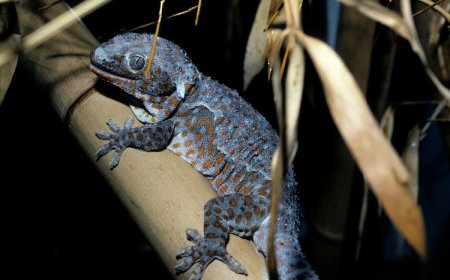Green Iguana Facts for Kids – Colorful Tree-Dwelling Lizard
Learn about the green iguana, a large herbivorous lizard that lives in tropical trees of Central and South America.
Green Iguana Facts for Kids - Colorful Tree-Dwelling Lizard
Scientific Name and Classification
-
Common Name: Green Iguana
-
Scientific Name: Iguana iguana
-
Kingdom: Animalia
-
Phylum: Chordata
-
Class: Reptilia
-
Order: Squamata
-
Family: Iguanidae
-
Genus: Iguana
-
Species: I. iguana
🐍 Introduction
The green iguana is a large, plant-eating lizard found in warm tropical regions of Central and South America, as well as parts of the Caribbean. Known for its bright green body, long tail, and excellent climbing skills, it is one of the most recognizable reptiles in the world.Green iguanas spend most of their time in trees, where they bask in the sunlight and feed on leaves, flowers, and fruits. They are skilled swimmers and can dive into water to escape predators.
🦎 Appearance
Green iguanas can grow between 5 and 7 feet (1.5-2 meters) long, with more than half of their length made up of their tail. Their skin is usually bright green but can also appear blue, brown, or orange, depending on their age, mood, and environment.They have a row of spines along their back, a large dewlap (flap of skin under the chin) for communication, and strong legs with sharp claws for climbing trees.
🌍 Habitat
These lizards live in tropical rainforests, coastal mangroves, and riversides. They are found from southern Mexico through Central America, down to Brazil and Paraguay, and on some Caribbean islands.They prefer areas with plenty of vegetation and access to water, often basking high in trees overhanging rivers.
🍽 Diet
Green iguanas are herbivores, eating mostly leaves, flowers, and fruits. Young iguanas sometimes eat insects, but adults rely almost entirely on plants. They use their sharp teeth to tear vegetation and need warmth from the sun to help digest their meals.
🔄 Life Cycle
Female iguanas lay 20-70 eggs in sandy burrows. The eggs hatch after about 90 days, and the hatchlings are independent from birth. Young iguanas live in small groups for protection but become more solitary as they grow.In the wild, they usually live 10-15 years, but in captivity they can live up to 20 years with proper care.
🐾 Behavior and Social Structure
Green iguanas are mostly solitary but may gather in groups where food is plentiful. They are diurnal (active during the day) and spend hours basking in the sun to regulate their body temperature.Males are territorial during breeding season, using head bobs, dewlap displays, and tail whips to warn rivals.
🛡 Conservation Status
-
IUCN Red List: Least Concern (LC)
-
Main Threats: Habitat loss, hunting for food, and the pet trade.
-
Conservation Efforts: Protected in some regions; breeding programs and awareness campaigns help reduce wild capture for the pet industry.
🎭 Cultural Significance
In many parts of Central and South America, iguanas are part of local cuisine and traditional medicine. In other places, they are kept as exotic pets, though caring for them requires specialized knowledge.In some Caribbean cultures, the green iguana is featured in folklore and stories as a symbol of patience and adaptability.
✨ Fun Facts
-
Can fall from 40 feet (12 meters) without injury.
-
Can hold their breath underwater for up to 30 minutes.
-
Males can turn bright orange during breeding season.
-
Use their tail as a whip for defense.
📌 Key Takeaways
-
Large, tree-dwelling lizard native to tropical regions.
-
Herbivore that mainly eats leaves, flowers, and fruits.
-
Excellent climber and swimmer.
-
Uses tail for defense and dewlap for communication.
-
Can live up to 20 years in captivity.
🐾 Kid-Friendly Summary
The green iguana is a bright, tree-loving reptile that enjoys a leafy diet and warm sunshine. With its strong legs and long tail, it climbs high into trees and can swim quickly to escape danger. These lizards are fascinating and important members of tropical ecosystems.
📚 Vocabulary Words
-
Herbivore - An animal that eats only plants.
-
Dewlap - A flap of skin under the chin used for display.
-
Spines - Stiff, pointed structures along the back.
-
Burrow - A hole or tunnel dug into the ground.
-
Tropical - A warm, humid climate near the equator.
-
Diurnal - Active during the day.
-
Territorial - Protective of an area from intruders.
-
Adaptability - The ability to adjust to different conditions.
🧠 Interactive Quiz
-
What do adult green iguanas mainly eat?
A. Insects
B. Meat
C. Plants
D. Fish
-
True or False: Green iguanas can swim well.
-
How many eggs can a female iguana lay?
A. 2–5
B. 10–20
C. 20–70
D. 100+
-
What is the green iguana’s conservation status?
A. Endangered
B. Vulnerable
C. Least Concern
D. Extinct
-
What is the flap of skin under an iguana’s chin called?
A. Crest
B. Dewlap
C. Pouch
D. Collar



















































